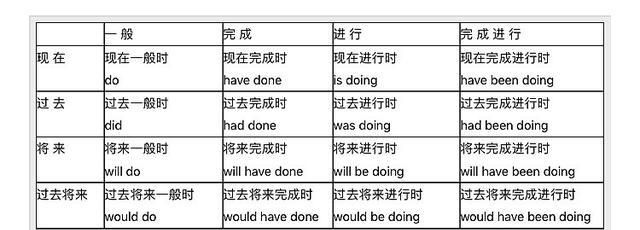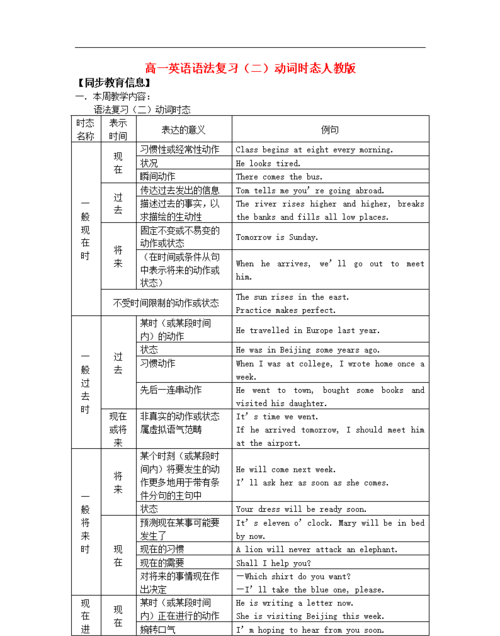本文目录
高中英语的时态有哪些
初中+高中英语语法
16种时态的详细介绍
一般现在时
1.表示现在习惯或经常反复发生的动作。常与always, usually, often, sometimes, every day (week, month)等连用。
He plays football twice a week.他每周踢两次足球。
I sometimes go to work on foot.我有时步行去上班。
2.表示现在的事实或状态。
It’s cold today.今天很冷。
You look tired now.你现在看起来很疲乏。
3. 现在时刻的状态、能力、性格、个性。
I don't want so much.
Ann Wang writes good English but does not speak well.
比较:Now I put the sugar in the cup.
I am doing my homework now.
第一句用一般现在时,用于操作演示或指导说明的示范性动作,表示言行的瞬间动作。再如:Now watch me, I switch on the current and stand back. 第二句中的now是进行时的标志,表示正在进行的动作的客观状况,所以后句用一般现在时。
4.表示格言或警句中。
Pride goes before a fall.骄者必败。
注意:此用法如果出现在宾语从句中,即使主句是过去时,从句谓语也要用一般现在时。
例:Columbus proved that the earth is round..
5.表示客观事实或普遍其理。
It’s far from the earth to the sun.地球与太阳间的距离很远。
Five and three makes eight.五加三得八。
5.表示已预先安排或计划好将来确定会发生的动作。
但主要用于go, come, leave, start, return, arrive等瞬间动词。
The train from London arrives at 7:00.从伦敦来的火车7:00到站。
He leaves on business the day after tomorrow.他后天出差。
6.在时间、让步及条件状语从句中表示将来的动作。
I’ll call you as soon as I get there.我一到那里就打电话给你。
I’ll come if he invites me.他如果邀请我我就来。
7.在以here, there开头的句子里,表示正在发生的动作。
Her comes the bus!汽车来了!
There goes the bell!铃响了!
当主语是代词时,代词必须放在动词之前。如:
There he comes!他来了!
8.某些表示心理状态和感觉的动词,如feel, love, hope, want, understand等表示现在发生的具体行为。
I feel pain in my head.我头疼。
I don’t understand what you mean.我不理解你的意思。
此时只用一般现在时而不用现在进行时。
9在由after,until,before,once,when,even if,in case,as long as,as soon as,the moment以及if,unless等引导的时间状语从句或条件状语从句中,通常用一般现在时代替将来时。例如:
1)I will tell him the news as soon as I see him.
2)I will not go to countryside if it rains tomorrow.
10某些表示起始的动词,可用一般现在时表示按规定、计划或安排要发生的动作,这类动词有:be,go,come,start,depart,arrive,begin,leave等。例如:
1)The plane leaves at three sharp.
2)The new teachers arrive tomorrow.
11在由why,what,where,whoever,who,that,as等引导的从句中,也常用一般现在时代替将来时。例如:
1)Free tickets will be given to whoever comes first.
2)You’ll probably be in the same train as I am tomorrow.
12一般现在时用于倒装句中可以表示正在发生的动作,动词以come, go为主。如:Here comes the bus. (车来了) / There goes the bell.(铃响了)。
13一般现在时常用于体育比赛的解说或寓言故事中。Now the midfield player catches the ball and he keeps it.
14一般现在时的特殊用法
a. 用于新闻标题或图片说明中
China Declares Manned Spaceflight Successful
中国宣布载人航天飞行圆满成功
Laura Bush Arrives in Moscow
劳拉·布什抵达莫斯科
b. 用于体育运动、表演等实况报道中
Francis slips past, passes the ball to Yao Ming, who jumps, catches and shoots it into the basket.
弗朗西斯穿过去,把球传给姚明,姚明跳起来,接住球投进篮里。
Now, look, I press the button and turn on the machine.
现在,看,我按下按扭,打开了这台机器。
c. 表示告诫或劝说
You mind your own business.
你不要管闲事!
If he does that again, he goes to prison.
如果他再那样的话,他就会进监狱的。
d. 表示现在瞬间的动作
Here comes the bus.
汽车来了。
There goes the bell.
铃响了。
一般过去时
1.表示过去发生的动作或存在的状态,常与表示过去时间的副词如:yesterday, last week, two hours ago等连用。
My family moved here five years ago.我家五年前搬到了这里。
I was born in 1973.我生于1973年。
2.表示过去一段时间经常或反复发生的动作。这时可与频度副词如:often, usually, always等连用。
He always worked into night those days.那些日子他总是工作到深夜。
I often left on business in 1987.1987年我经常出差。
表示“过去经常,而今不再”时,要用used to。如:
I used to read newspaper after breakfast.
我过去经常早饭后看报纸。(意指现在已不是这样)
The children often swam in this river. 孩子们过去经常在这条河里游泳。
3.表示过去连续发生的一连串动作。
He put down the heavy box, took out the keys, and opened the door.
他放下这沉重的箱子,掏出钥匙开了房门。
过去发生的一连串动作,若用and, or, but等并列连词连接,则一律用过去式。
They moved the chairs to the table, sat down and began to have supper.
他们把椅子搬到桌边,坐下开始吃饭。
4.在时间和条件状语从句中,用一般过去时表示过去将来的动作。
He said that he would let me know as soon as he got the information.
他说他一得到消息就立即让我知道。
Mary told me that she would stay at home if it rained.玛丽告诉我如果下雨她就呆在家里。
5表示过去某一特定时间所发生的、可完成的动作或状态,常与表示确切过去时间的词、短语或从句连用。例如:
We went to the pictures last night and saw a very interesting film.
6表示过去习惯性动作。例如:
1)He always went to class last.
2)I used to do my homework in the library.
(注意与be used to doing短语的区别)
7,讲故事、对过去经历的回忆、双方都明白的过去事件等一般用过去时,而且经常省略时间状语。如:I happened to meet Rose in the street.(我正好在街上遇到露西)
8一般过去时的特殊用法
a. 在虚拟语气中表示现在或将来时间的动作或状态
It's time we went.
是我们该走的时候了。
I wish I were twenty years younger.
但愿我年轻20岁。
I would rather you didn't do anything for the time being.
我宁愿你暂时先不要采取什么措施。
b. 在口语中,一般过去时往往显示委婉客气。
I wondered if you could give me a hand.
我想请你帮个忙。
Might I come and see you tonight?
我想今晚来看你,好吗?
9句型:
It is time for sb. to do sth"到……时间了""该……了"
It is time sb. did sth. "时间已迟了""早该……了"
It is time for you to go to bed.你该睡觉了。
It is time you went to bed.你早该睡觉了。
would (had) rather sb. did sth.表示'宁愿某人做某事'
I'd rather you came tomorrow.
10 wish, wonder, think, hope 等用过去时,作试探性的询问、请求、建议等。
I thought you might have some. 我以为你想要一些。
比较:
一般过去时表示的动作或状态都已成为过去,现已不复存在。
Christine was an invalid all her life.
(含义:她已不在人间。)
Christine has been an invalid all her life.
(含义:她现在还活着)
Mrs. Darby lived in Kentucky for seven years.
(含义:达比太太已不再住在肯塔基州。)
Mrs. Darby has lived in Kentucky for seven years.
( 含义:现在还住在肯塔基州,有可能指刚离去)
注意: 用过去时表示现在,表示委婉语气。
1)动词want, hope, wonder, think, intend 等。
Did you want anything else?
I wondered if you could help me.
2)情态动词 could, would.
Could you lend me your bike?
一般将来时
一般将来时是由“will / shall + 动词原形”构成的。shall只限于第一人称,主要见于英国英语,现在的趋势是第一、二、三人称的单复数形式均用will表示。在口语中,shall和will常缩写成“'ll”,紧接在主语之后。其否定式shall not 和will not 常简略为shan't 和won't。在状语从句中用一般现在时表示将来。在以第一人称为主语的问句中,常用 shall 表示提议和询问情况,在以第二人称作主语的问句中,用will 表示请求。当主语是第一人称时,用will 表示意愿.决心.允诺.命令等
(1)表示将要发生的动作或存在的状态,常与表示将来的时间状语如next month, tomorrow, in a week, soon等连用。
I will go to the zoo next Sunday.下周日我将去动物园。
She’ll go to the cinema tonight.今晚她将去看电影。
注意:
在口语中,常用will / shall + be doing结构来代替will / shall + 动词原形,以表示生动。
I'll be seeing a friend off at the airport.
我要去机场给一个朋友送行。
He'll be going with us tomorrow.
他明天和我们一起去。
(2)表示将来经常发生的动作或某种必然的趋势
Some birds will fly away to the south when winter comes.
冬季来临时,一些鸟儿将飞往南方。
(3)表示将来打算进行或期待发生的动作或状态。例如:

高中英语的时态有哪些
一 般
完 成
进 行
完 成 进 行
现 在
现在一般时
do
现在完成时
have done
现在进行时
is doing
现在完成进行时
have been doing
过 去
过去一般时
did
过去完成时
had done
过去进行时
was doing
过去完成进行时
had been doing
将 来
将来一般时
will do
将来完成时
will have done
将来进行时
will be doing
将来完成进行时
will have been doing
过去将来
过去将来一般时
would do
过去将来完成时
would have done
过去将来进行时
would be doing
过去将来完成进行时
would have been doing
注:构成时态的助动词be (is, am, are), have (has, have), shall, will 等需根据主语的变化来选择。
在这16种时态中,其中有8种时态是最重要的,也是用得最多的,是初学者必须要掌握的,它们是一般现在时(也称一般现在时)、一般过去时(也称一般过去时)、一般将来时(也称一般将来时)、现在进行时、现在完成时、过去进行时、过去完成时、过去将来一般时(也称过去将来时),其余的时态相对用得较少。
1. 一般现在时
用法:
A) 表示现在发生的动作、情况、状态和特征。
B) 习惯用语。
C) 经常性、习惯性动作。
例:He always helps others. (他总是帮助别人。)
D) 客观事实和普遍真理。尤其要注意,如果前后文不是一般现在时,则无法保持 主句、从句时态一致。
E) 表示一个按规定、计划或安排要发生的动作,(仅限于某些表示“来、去、动 、停、开始、结束、继续”等的动词 )可以与表示未来时间的状语搭配使用 。常见的用法是:飞机、火车、轮船、汽车等定期定点运行的交通方式。
例:The next train leaves at 3 o'clock this afternoon.
(下一趟火车今天下午3点开车。)
How often does this shuttle bus run? (这班车多久一趟?)
F) 在时间和条件状语从句里经常用一般现在(有时也用现在完成时)表示将来事 情。
例:When you have finished the report, I will have waited for about 3 hours.(等你完成这份报告的时候,我就已经等了将近3个小时了。)
2. 现在进行时(be doing)
用法:现在正在进行的动作。
3. 现在完成时(have done)
用法:
A) 表示动作到现在为止已经完成或刚刚完成。
例:I bought a new house, but I _________ my old one yet, so at the moment I have two houses.
A) didn't sell B) sold C) haven't sold D) would sell
答案是C) haven't sold。
B) 表示从过去某时刻开始,持续到现在的动作或情况,并且有可能会继续延续下去。此时经常用延续性动词。时间状语常用since加一个过去的时间点,或for 加一段时间,或by加一个现在时间。
例:Great as Newton was, many of his ideas ___________ today and are being modified by the work of scientists of our time.
A) are to challenge C) have been challenged
B) may be challenged D) are challenging
全句的意思是:“虽然牛顿是个伟大的人物,但他的许多见解直到今天还在受到挑战,并且被现代科学家的工作所修正。”challenge是及物动词,在本句中应当是被动语态;其动作延续到今天,所以要用现在完成时态。可见答案是C) have been challenged。A) are to challenge和D) are challenging都是主动语态,不可能是答案。B) may be challenged虽然是被动语态,但意思与全句内容不合,所以不对。
C) 表示发生在过去,但对现在仍有影响的动作或情况。通常用点动词,如:arrive, begin, find, give, lose等。
例:John has broken his left leg.(约翰摔断了左腿。)
注意事项
A) 现在完成时是联系过去和现在的纽带。现在完成时和过去时的区别在于:现在完成时强调动作的动态,或受动态的影响,是动态的结果,对现在有影响;过去时只表示过去的某个具体时间里发生的动作,与现在没有联系。
例:He worked in that hospital for 8 years.(他曾经在那家医院工作了8年。这只是讲述一个过去的事实,他现在已经不在那家医院了。)
He has worked in that hospital for 8 years.(他已经在那家医院里工作了8年。表示他从过去开始工作,一直工作到现在,现在仍在那家医院工作。)
B) 因为含有for加一段时间或since加一个时间点这样的时间状语的完成时,有动态和延续性的特点,所以不能使用终端动词或瞬间动词。
例:My sister has been married for 5 years.(过去分词做表语表示状态,可以延续)
My sister has married. Don't disturb her.(终端动词)
C) 在"this is the first/ second/ third…… time that……"句型里要求用完成时。
例:This is the second time that the products of our company have been shown in the International Exhibition.(这是我公司产品第二次参加国际展览会。)
D) 句型"It is/ has been……since"所使用的两种时态都正确。
例:It is/ has been 10 years since I last saw him.(从我上次见到他以来已经10年了。)
E) 在"no sooner than"、"hardly/ scarcely ……when"、"before"、"prior to"等句型中,主句要求完成时。
例:I haven't met that professor prior to today.(以前我从未见过那位教授。)
4. 现在完成进行时(have been doing)
用法:表示某一动作开始于过去某一时间,延续或重复地出现至今,或将继续延续至将来。
例:We have been working on this project for over a month now.(到目前为止,我们一直在处理那个项目,已经花了一个多月时间了。)
注意事项:与现在完成时相比,现在完成进行时更强调:在从过去到现在的时间里,动作或状态一直持续或一直反复出现。
例:1997年6月四级第45 题
It seems oil ___________ from this pipe for some time. We'll have to take the machine apart to put it right.
A) had leaked B) is leaking
C) leaked D) has been leaking
从本题上下文看,这两个句子的意思是:“看来,这个管道漏油已有一段时间了,我们将不得不拆卸机器排除故障。”第二句表示将要采取的措施。第一句动作发生在第二句之前,并且延续到现在为止仍在继续。因此,空格中需用现在完成时或现在完成进行时。D) has been leaking是现在完成进行时,因此是本题的答案。有11%的考生误选了B) is leaking。由于本句有时间状语for some time,表示谓语动作延续,谓语不能用现在进行时,必须用和完成时有关的时态。有些考生误选了C) leaked或A) had leaked。是因为他们没有注意到本题第二句是一般将来时,所以第一句的谓语不能用过去时或过去完成时。
5. 一般过去时
用法:
A) 表示过去某个时间发生的动作或情况。
B) 表示过去习惯性动作。特别是由would/ used to do表达的句型,本身表示的 就是过去时。
例:The old man would sit on a bench in the quiet park and look at others for hours without doing anything or talking to anybody.(老人过去常常坐在宁静的公园里的一条长椅上,看着其他的人,一坐就是数个小时,什么也不干,也不和任何人交谈。)
He used to visit his mother once a week.(他以前总是每周看望一次他的母亲。)
C) 有时可代替一般现在时,表达一种婉转、客气、礼貌、商量的语气。
例:I wanted to ask you if I could borrow your car?(我想向您借车用一用,可以吗?)
Would you mind my sitting here?(您介意我坐在这里吗?)
注意事项:
A) 注意时间状语的搭配。一般过去时的时间状语应该是表示过去某个时间的词或词组,如:yesterday, last month, in 1999, two days ago等,绝对不可与recently, in the past 10 years, this month等连用,因为这样的时间状语都与现在有关系,应该用现在完成时或一般现在时。
B) used to do的否定形式和疑问形式很特别:你怎么写都正确。以否定形式为例:used not to do, didn't used to do, didn't use to do都对。
Used to do经常与 be used to doing sth/ sth结构进行对比。前者表示"过去常常或过去曾经",要求加动词原形;后者表示"习惯于",要求加名词或动名词。
6. 过去完成时(had done)
用法:表示在过去的某个时间或动作以前已经发生的动作或已经存在的状态。就是我们常说的:表示"过去的过去的动作或状态"。
Until then, his family _________ from him for six months.
A) didn't hear C) hasn't heard B) hasn't been hearing D) hadn't heard
全句的意思是:“到那时为止,他家里已经有六个月没得到他的消息了。”由此可以看出,谓语动词的动作延续到过去的某一时刻才完成,因此谓语要用过去完成时。答案是D)。其它选项中:A) didn't hear,因为一般过去时只表示过去发生的事情或存在的状态,所以不能与时间状语for six months连用。B) hasn't been hearing,现在完成进行时表示过去某时刻继续到现在或现在还在进行的动作,与题意不符。C) hasn't heard,现在完成时表示从过去某一时刻到现在为止发生的动作。而题中的then只表示过去的某一时刻,不能表示现在时间。
注意事项:“过去的过去”这种逻辑关系常通过上下文体现出来,而不一定受某个时间状语的限制。
例:There had been some one in our room just now, because I noticed a burning cigarette end on the floor when we opened the front door.(刚才有人在我们的房间里,因为我们打开前门进来时,我注意到地板上有一支仍在燃烧的香烟。)
分析:虽然时间状语是just now,似乎应该使用一般过去时,但是“在房间里”这个状态是在"开门"和"注意"这两个过去的动作之前就存在的,所以应该用过去完成时。
7. 过去将来时(would/ should do)
用法:表示从过去的某个时间看将要发生的事。
例:I said on Thursday I should see my friend the next day.(我星期四说我将于第二天拜访我的朋友。)
注意事项:由于过去将来时是由过去时和将来时组合而成的,所以其注意事项可以参考过去时和将来时的相关注意事项。想学习更多英语知识,请关注口袋英语aikoudaiyy
8. 过去进行时(was/ were doing)
用法:
A) 表示在过去一个比较具体的时间正在发生的动作。
例:Mary was listening to light music 10 minutes ago.(10分钟前,玛丽正在听轻音乐。)
B) 如果when, while这样的时间状语引导词所引导的主从句之一是一般过去时,则另一个句子常用过去进行时。
例:I was washing my hair when you knocked at the front door.(你敲前门时我正在洗头发。)
注意事项:其它与将来时有关的事项请参见下面所讲的一般将来时。
9. 一般将来时
用法:
A) 基本结构是will / shall do。
例:We shall send her a glass hand-made craft as her birthday gift.(我们将送给她一个玻璃的手工制品,作为给她的生日礼物。)
B) 有些动词,如:arrive, be close, come, do, done, go, have, leave, open, play, return, sleep, start, stay等,用于一般进行时,并且通常与一个表示将来时间的时间状语连用,可以表示将来时。
例:My mother is coming to visit me next week and is staying here until May.(我妈妈下周将来看我,并会呆到5月。)
C) 表示“打算去……,要……”时,可用be going to do。
例:This is just what I am going to say.(这正是我想说的。)
D) 表示“即将、正要”时,可用be about to do。强调近期内或马上要做的事。
例:Don't worry, I am about to make a close examination on you.(别担心,我马上就给你做一次仔细的检查。)
E) "be to do"的5种用法:
a) 表示“按计划、安排即将发生某事或打算做某事”。
例:She is to be seen in the lab on Monday.(星期一你准会在实验室见到她。)
b) 该做或不该做的事情(语气上接近于should, must, ought to, have to),表示一种命令、规劝性语气。
例:You are to go to bed and keep quiet, kids. Our guests are arriving in less than 5 minutes.(孩子们,你们必须 上床睡觉,不准吵闹。我们的客人5分钟之内就要到了。)
c) 能或不能发生的事情(接近can, may)
例:How am I to pay such a debt?(我怎么可能还得起这么大的一笔债呢?)
d) 不可避免将要发生的事情,后来将要发生的事情。
例:I assure you that the matter _______ as quickly as possible. Have a little patience.
A. will be attended B. will be attended to
C. is attended D. is attended to
will be attended to关键的一点是:attend表示“处理,解决”时是不及物动词,必须与to连用。另外,从上下文看,事情显然尚未解决,所以应该用将来时的被动语态。答案是B。
e) 用于条件从句“如果……想,设想”(接近if ……want to,或if ……should)
例:Greater efforts to increase agricultural production must be made if food shortage ____________ avoided.
A) is to be B) can be C) will be D) has been
答案是A) is to be。全句的意思是:“如果要避免食品短缺,就必须作出更大努力来增加农业产量。”
F) 同样可以表示“正要、将要”的意思的句型是be on the point of doing。
例:The coach is on the point of giving up the game because our team has been scored 7 points.(教练想要放弃这场比赛了,因为对方已经射进了7个球。)
例:1999年6月四级第65题
I was _______ the point of telephoning him when his letter arrived.
A) in B) to C) at D) on
答案是D)。on the point of doing 是固定词组,意思是“正要、打算”。全句的意思是:“当他的信到的时候我正要打电话给他。”
注意事项:
在以if, when, as long as, as soon as, after, before, in case, until, unless等连词以及具有连词作用的副词(immediately, the moment, directly)等引导的状语从句,一般用现在时代替将来时。强调延续性或动态时,可用完成时。
例:I hope his health will have improved by the time you come back next year.(我希望到明年你回来的时候,他的身体已经好多了。)
10. 将来进行时(will be doing)
用法:强调在将来的某个具体时间正在发生的动作或事情。
例:Don't worry, you won't miss her. She will be wearing a red T-shirt and a white skirt at that time.(别担心,你不会认不出她的。她到时会穿一件红色的T恤衫和一条白色的短裙。)
注意事项:由于本时态是由将来时和进行时融合在一起的,所以关于本时态的注意事项,可参考"一般将来时"和"现在进行时"的有关注意事项。
11. 将来完成时(will have done)
用法:表示从将来的某一时间开始、延续到另一个将来时间的动作或状态,或是发生在某个将来时间,但对其后的另一个将来时间有影响的动作或状态。就好象把现在完成时平移到时间轴的将来时时段一样。其用法从和过去及现在有关,变成了和将来及将来的将来有关。
例:1997年1月四级第22题
The conference __________ a full week by the time it ends.
A) must have lasted B) will have lasted
C) would last D) has lasted
本题考核谓语动词的时态。全句的意思是:“会议从开始到结束将持续整整一个星期。”句中by the time it ends表示动作要延续到将来某一时刻,因此要用将来完成时。答案是B) will have lasted。如果选A),因为情态动词must后面接动词不定式的完成时形式表示对已经发生的事情的一种肯定推测,而本句的时间状语是by the time it ends而非by the time it ended,所以犯了时态不呼应的错误。Would虽可以表示推测或可能性,但would last不能表示延续到将来某一时刻的动作,所以C) would last错误。因为D) has lasted是现在完成时,表示到现在为止已经完成的动作,不能表示延续到将来某一时刻的动作,所以也不正确。
注意事项:由于本时态是由将来时和完成时融合在一起的,所以关于本时态的注意事项,可以参考“一般将来时”和“现在完成时”的有关注意事项。想学习更多英语知识,请关注口袋英语aikoudaiyy
12)将来完成进行时:shall have been doing ,will have been doing
例:By the end of next month, the project will have been being worked for 3 years. (到下个月底为止,这项工程就已经不停地进行了3年了。)(被动语态)
13)过去完成进行时:had been doing
例:The old clock had been being taken apart of and fixed up again for several times by my 10-year old son before I came back home.(我回到家之前,我10岁大的儿子已经把这个旧钟表拆卸并重新组装了好几回了。)(此处强调“拆卸”和“组装”这两个过去的过去的动作一直在反复进行。)(被动语态)
14) 过去将来进行时:should be doing , would be doing
例:The government promised that a new highway would be being built next July.(政府承诺说第二年7月将有一条新的高速公路正在修建。)(此句的时间状语是具体的将来时间,所以最好用将来进行时。)(此句为被动语态)
15) 过去将来完成时:should have done , would have done
例:I believed by the end of that year an advanced version of that software would have been developed, but I was wrong.(我坚信到那年年底为止,那个软件的新版本将被开发出来。但是我错了。)(此句为被动语态)
16) 过去将来完成进行时:should have been doing , would have been doing
例:They said that by the end of the following month, the project would have been being worked for 3 years. (他们说到第二个月底为止,这项工程就已经不停地进行了3年了。)

高中英语时态总结表格
一般现在时:主+谓(is/am/are/do/does)+宾;一般过去时:主+谓(was/were/did)+宾
一般将来时:①主+谓(is/am/are going to do)+宾;②主+wiil +do+ sth ;③主+be (is/am/are) about to do sth ;过去将来时:主+would+do+宾;现在完成时:主+have +done+宾;过去完成时:主+had+done+宾。 这些的句子结构都是主+谓+宾的结构。句子结构:1、主+谓(及物动词vt)+宾; 2、主+谓(不及物动词vi);3、主+谓+宾+宾补、、、、、、、

以上就是关于高中英语的时态用法及结构,高中英语的时态有哪些的全部内容,以及高中英语的时态用法及结构 的相关内容,希望能够帮到您。

